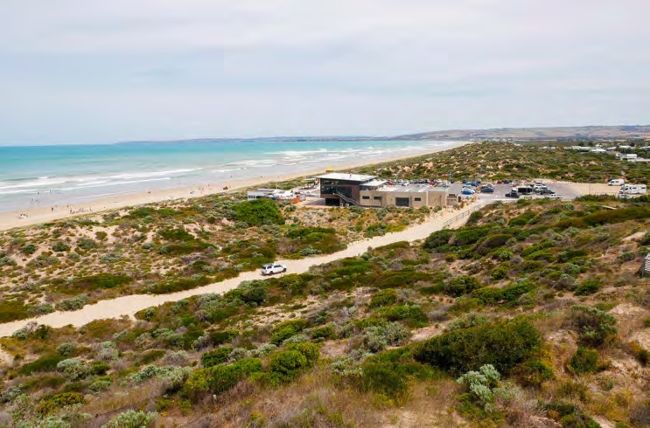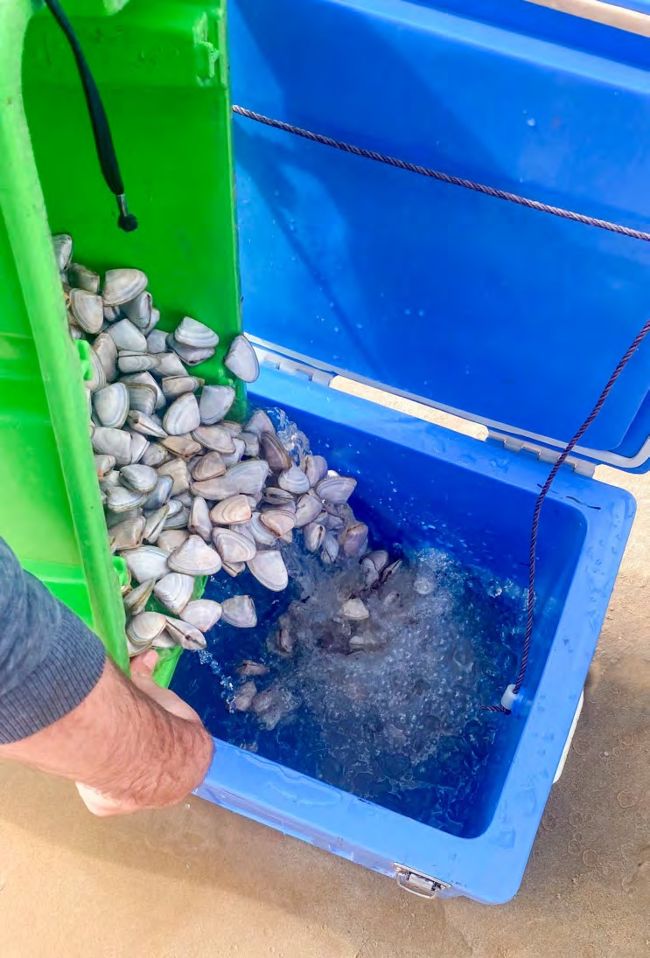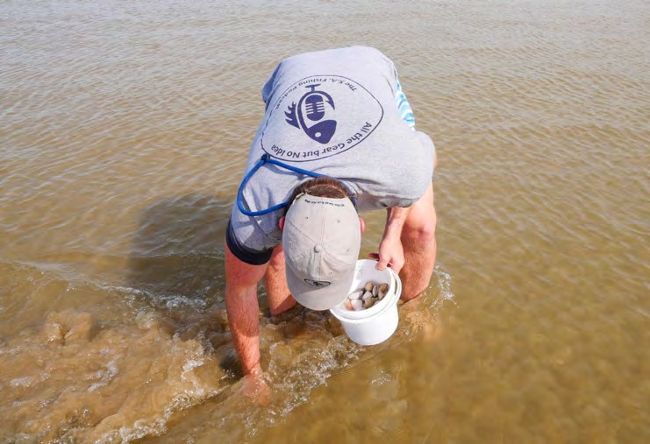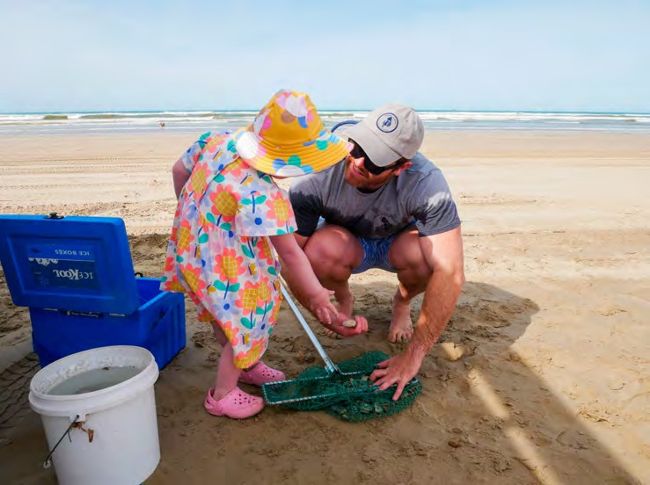GOOLWA BEACH COCKLING
With the cost of buying cockles for bait on the rise and the growing popularity of ‘vongole’ as a seafood dish, the appeal of heading down to Goolwa and collecting your own has never been greater. Not only can it get you a free meal or cheap bait, it is also an excellent day out for the whole family.
Matt Rohde reports.
Situated about an hour and fifteen minutes from Adelaide, Goolwa Beach is home to a very healthy population of the pipi or Goolwa cockle, named after the beach where it is most famously found.
The annual season runs from November 1 until May 30, with a five-month closure running across winter each year. It is also worth noting that most years fishing for cockles is closed for a period at some point throughout the season when E Coli is detected at unsafe levels, so it is well worth keeping an eye out for this.
Collecting these cockles is allowed all along Goolwa Beach up until the Murray Mouth. The section of the Coorong Beach from the Murray Mouth to 28 Mile Crossing, about halfway between Salt Creek and Kingston, is closed for recreational collecting of cockles. This zone of the Younghusband Peninsula is allocated for commercial fishing of cockles only, and is much less accessible to the wider public anyway.
Much of this fishery can only be accessed by four wheel drive, as you generally need to drive across the sand to find a good spot.
Alternatively, the beach can be accessed from the main Goolwa beach carpark, with some cockles found within walking distance.
However, these are often hard to come by, as they are subject to a much higher fishing presence. Each season is different, and we can remember collecting cockles by the handful at the eastern end of Middleton Beach a number of years ago.
For those who are accessing Goolwa Beach by four wheel drive, access to the beach is via a short track that begins behind the Surf Life Saving Club in the main Goolwa Beach carpark. It is a short drive through softer sand that can often get quite dug up during the busy summer periods, making the driving a bit more challenging. The rest of the year the track is normally OK and shouldn’t cause too many troubles for a capable four wheel drive if the tyre pressure is reduced. Every year over the busy summer period there are several ‘all wheel drivers’ who decide to ignore the signs indicating four wheel drives only, and try their luck to get onto the beach. Inevitably, some of them end up bogged and cause a big queue to get on and off the beach while someone pulls them out with a snatch strap.


Once onto the main beach, the driving is generally easier, with much of the beach made up of flat compacted sand. At certain times of the year the sand can be a bit softer around high tide, and after storms the beach can end up split into two levels with a steep step-up causing a hazard as well. There is also a small section towards the end of the beach where cars are diverted onto a track through the sand dunes, which goes around a large pipe coming from the dredging operation around the Murray Mouth entrance and adjacent Coorong.
The beach continues on for around 10km in total, ending at the Murray Mouth, a popular spot for people to stop for a look and for fishing either in the protected waters of the Coorong or for those a bit more game or experienced in the surf out from the Murray mouth. Recently the rules have changed in regards to driving on sand, and as of December 1 2023, the default speed limit on all beaches is now 40km/h and 25km/h within 50m of any pedestrians.
The gear required for a cockle collecting mission can be pretty minimal, however there are several extra items that can make it an easier and more efficient operation. A bucket or esky to collect the cockles is essential, as is a cockle measurer or ruler to ensure any cockles you are keeping are over the 3.5cm limit. Many tackle shops stock specialised cockle nets, made up of a narrow rectangular opening on a handle, with a net or mesh bag to collect the cockles once you have disturbed them up out of the sand. A sieve or bucket with small holes to allow the sand to wash off the cockles can also be beneficial.
Finding a good patch of cockles can be half the battle of collecting them. They can be scattered anywhere along the 10km stretch of beach, and some areas will have plenty while others only seem to have a couple. Finding them in abundance can be a challenge. They live in the sand under the shallow water where the waves wash back and forth, and are only buried a short way under the surface so can be easily dug out using your hands. At high tide the area in which they are plentiful can be covered by deeper water, making the task more challenging, so often a lower tide can be best. Driving along the beach, it is very difficult to pick the best spot to start digging for cockles and often the only sure way of knowing where they are is to jump out of the car, have a quick dig around and see if you find any. If there are none or very few after a couple of minutes’ digging around in amongst the white wash, it is best to jump back in the car and keep moving along the beach. Sooner or later you will stumble upon a spot where you pull out a few cockles on your first handful of sand, and if this continues, it is worth parking the car and setting up for a proper effort at this particular spot. A mate of ours who is the self confessed ‘Cockle Whisperer’ believes that if you have your feet in for 15 seconds and feel nothing, you should move on, showing how quickly you can often tell if a spot is worthwhile sticking to.

A cockle rake makes the job easier
Once you’ve found a spot to have a proper go, it is worth getting the bathers on, as you’re inevitably going to get wet when a wave sneaks up behind you! We also put the kids in a lifejacket, as the waves can be unpredictable, and if your kids are anything like ours, they will quickly want to get in on the activity. This is where you can pick your own method to collect the cockles – sitting down or bending over and digging by hand or using a shovel and picking through the scoops can both be productive. However, the most popular method is commonly known as the ‘cockle shuffle’ where you dig your feet into the sand and twist from side to side. As the water retracts, the cockles will be dislodged and a mate can use a cockle net to catch them as they wash back towards the water. You may also feel them under your feet while doing this and reach in to collect them yourself before they wash away.
It can be hard to keep track of how many cockles you have, and also some thought needs to go into storing the cockles as you collect them. Some will tie a mesh bag onto their waist and put each handful into this before walking up to the esky to unload, before sorting them out and checking they are over the legal size of 3.5cm. Others will take it in turns to hold a bucket and check their size as they go. Either way, it is essential to stop and do a stocktake to make sure you stay under the legal bag limit. As of November 1, 2024, when the summer cockle season opens, the bag limit has been increased to 330 per person (was 300 previously) or 990 per vehicle (was 900 previously), making a cockling trip to Goolwa a bit more worthwhile.
The next big question is what to do with your catch, with dinner or bait the two most likely options. Cockles, or vongole as they are known in culinary circles, are growing more popular both at restaurants and for those cooking at home, with pasta dishes tending to be the most popular, often with a marinara or white wine-based sauce. If you are planning to eat the cockles, it is important to first purge them – a process of removing all or most of the sand that is within the cockle shell and will otherwise ruin the dish. This is done by putting the cockles in an esky of seawater and leaving them to spit out or purge the sand out of the shell.
It is best to swap the water over with fresh, cold seawater a few times over a 24 hour period, removing all the sand from the bottom of the esky each time. This is obviously done most easily if you are near the ocean, but otherwise adding salt to freshwater will suffice.
Alternatively, the cockles make a great bait for a wide variety of our local bread and butter species, particularly SA’s iconic King George whiting. We keep the cockles on ice until we get back home, before splitting them up into batches of about 30-40, which are vacuum sealed and frozen. This makes it easy to only defrost the amount of cockles that you need on a particular day’s fishing.
Vacuum sealing them does tend to keep them fresher for longer and prevent any freezer burn if some of the cockles are slightly open when frozen. With the price of cockles sold at tackle shops and service stations across the state rising so rapidly, this is well worth the effort to save some money! At one stage in the past 12 months we paid $56 for three small bags of cockles at a service station on our way down the Yorke Peninsula, so that proves just how valuable collecting your own bait can be.
Whether it be for bait or for dinner, a day out cockling at Goolwa Beach is a great activity for the whole family and well worth scheduling into your summer fishing plans!

Cockling is made for kids!